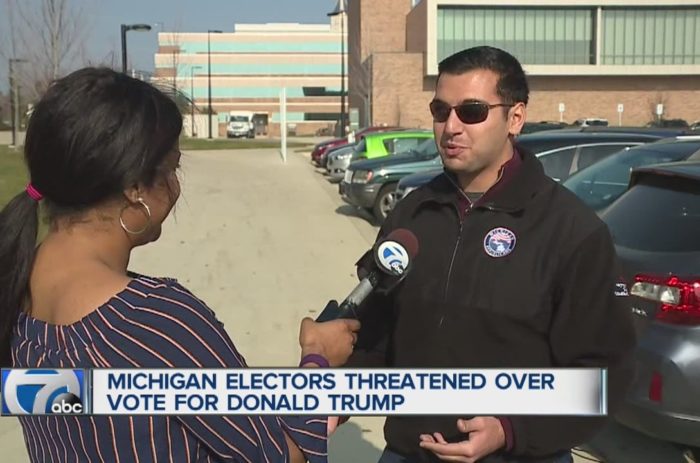The following is an excerpt from OpinionJournal.com’s “Best of the Web” written by the editor, James Taranto.
The Veteran
“What if it was ‘Oh, the gay one,’ or ‘Oh, the Asian kid?’ ” asks Maggie Kwok, head of the Penn State Veterans Organization in an interview with the Daily Collegian, PSU’s student newspaper. She is referring to a “training video,” prepared by the university’s Counseling and Psychological Services office, depicting “worrisome student behavior.”
The office swiftly removed the video when it prompted a kerfuffle, but the PSU College Republicans preserved it on YouTube. It’s a fascinating documentation of academic prejudice.
Just shy of five minutes, the video depicts a vignette in two scenes. As it opens, a timorous young female instructor is talking with an older man, perhaps the department chairman. We join the conversation as it is about to wrap up, before she brings up a new and worrisome subject:
Instructor: . . . So, I think that we should talk to everybody about that.
Chairman: Good, let’s bring it up at the staff meeting, OK?
Instructor: Actually, I kinda wanted to talk to you about something else? Um, I’m still having problems with that student I mentioned?
Chairman: The Veteran.
Instructor: Yeah. He’s having problems with his papers still. His grammar is really poor, and he veers off subject, and he’s just not really seeming to understand the assignments.
Sound familiar? “You know, education–if you make the most of it, you study hard, you do your homework, and you make an effort to be smart, uh, you can do well. If you don’t, you get stuck in Iraq.”
The video’s salient stereotype, however, is not of veterans as thickheaded but as angry. The instructor reluctantly tells the chairman that the student’s “tone is very confrontational, and I feel like he’s always on the verge of losing his temper.” The chairman asks if he has threatened her or if she is “worried about what he might do.” She says no, but “he makes me really uneasy.” He gives her some obvious advice, beginning: “If he ever threatens you, you call the police right away.”
After this inconclusive chat, the story shifts to the classroom, where The Veteran confronts the instructor, demanding to know why he only got a C-plus on his paper even after rewriting it to her specifications. She says that while there was some improvement after the rewrite, she graded the paper on the merits. He thinks she has it in for him and says, “I don’t see why you’re doing this”:
Instructor: I’m not doing anything, Matthew. This isn’t a personal thing against you.
The Veteran: I think it is! You’ve made it very clear in class how you feel about the war, and you’re taking it out on me!
Instructor: My personal beliefs have nothing to do with the way that I treat you. I think that you need to relax and we need to discuss this. Or I could give you the name of someone to talk to if you feel like you want to get some help.
The Veteran: Help? Do you think I’m an idiot? You’re the one who’s being unreasonable! I just want the grade that I deserve. [Pauses.] You know what? You’ll see, you’ll be sorry. I’m gonna get you fired.
With this, The Veteran exits stage left. Fade to black as the instructor’s jaw goes slack in an expression midway between terror and pensiveness.
“Penn State spokeswoman Lisa Powers said the university responded to the veterans’ concerns as quickly as possible by removing the video,” the Collegian reports:
“We heard them, we responded and there was certainly no intent to suggest that any particular student group was inclined toward worrisome behavior,” Powers said. . . .
“Obviously someone has taken our video and has posted it elsewhere,” Powers said. “Since it has been posted on the Internet, we have received some e-mails from veterans and friends of veterans who have seen the video out of context.”
We watched the other three videos in the series, and we must say we don’t see how the “context” ameliorates the veterans’ objections to the depiction of The Veteran.
All the videos in the series concern students behaving in ways that are creepy but not necessarily dangerous. In the first, a young woman tells her professor that a young man in her class has an unreciprocated romantic interest in her and has been making her feel uncomfortable. “It’s not like he’s stalking me or anything,” she allows, but then she describes behavior that some may reckon crossed that line.
The second depicts a female student who is behaving erratically for reasons that are unspecified–perhaps trauma, mental illness or drug abuse.
The third shows a classroom discussion on news coverage of violent crime. When the conversation turns toward school shootings, a black-shirted male student in the back row remarks that such violence “doesn’t make sense to me. Why shoot at the other students? Personally, I’d blow up Old Main or shoot up the administration. That’s where the real problems are.”
The video about The Veteran is similar to the others, in that all depict abnormal behavior by young people who probably are normal, but are immature or temporarily impaired. But the characters in the other videos are all completely generic, with no distinguishing characteristics other than their sex. Only The Veteran is fleshed out enough even to be a stereotype.
The obvious objection to the depiction of The Veteran is that there is no reason to think that veterans are more prone than anyone else to lash out angrily, blaming others for their own failings. If anything, one would think that the rigors of military training and deployment would leave them more mature, at least in this regard.
But The Veteran’s status as a veteran is relevant to the video’s story, inasmuch as he believes the instructor is treating him unfairly because he is a veteran. This lends another dimension to Maggie Kwok’s speculation about the reaction if the character were depicted as a member of an ethnic or sexual minority.
What if the student in the video were black and accused the instructor of racial discrimination? Would this be depicted, as it is in this video, as if the charge was absurd on its face? Would the student’s threat to have the (presumably untenured) instructor “fired” come across as an empty one, the way it does in the actual video? And if the department chairman in the opening exchange identified the student by asking, “Oh, the black guy?,” would that not be seen–with some justification–as bolstering the charge of discrimination?
In the video, The Veteran behaves inappropriately–but he also accuses the instructor of inappropriately bringing her politics into the classroom at his expense. We are meant to think the accusation is preposterous. But at a university that produces such a video, is it hard to believe that such things actually go on?
For more “Best of the Web” click here and look for the “Best of the Web Today” link in the middle column below “Today’s Columnists.



